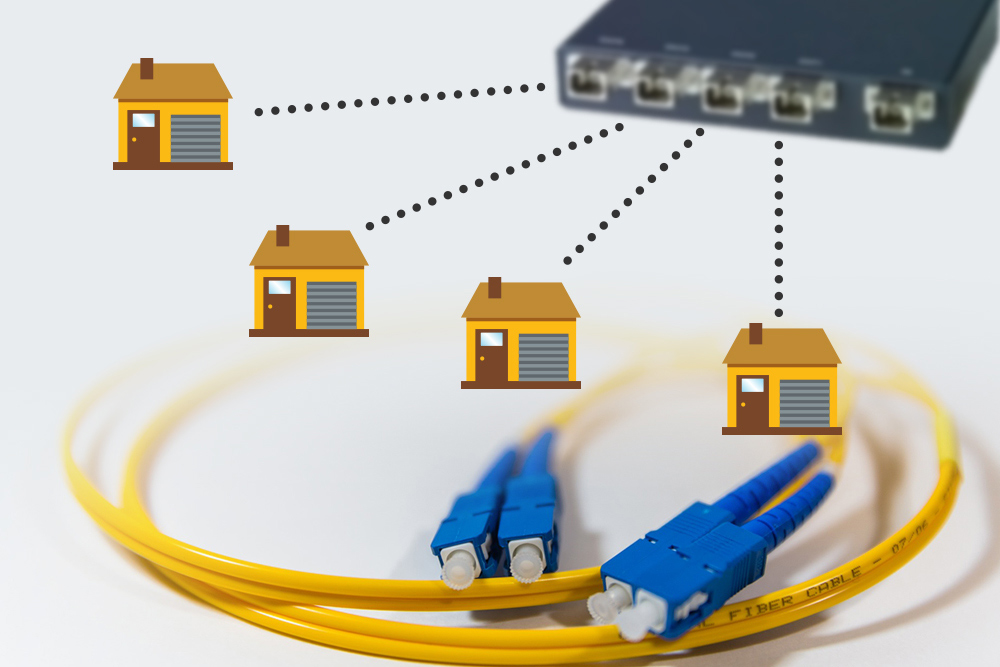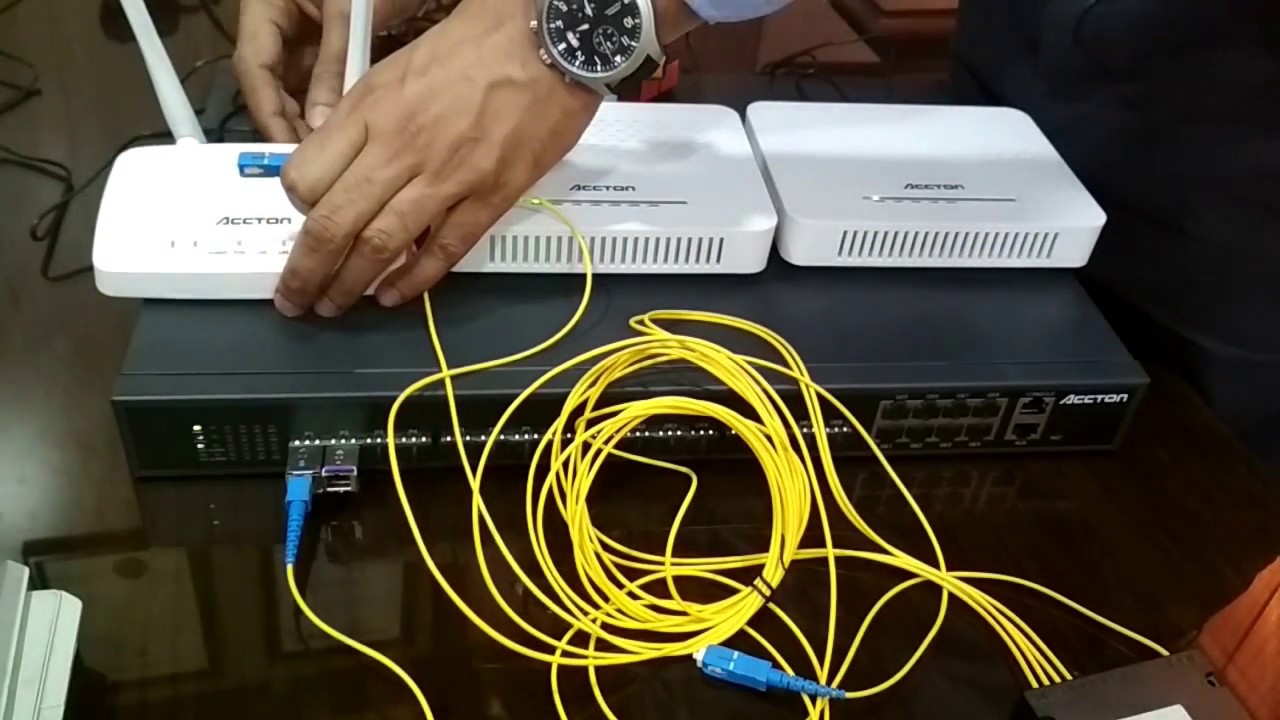
As the wide use of broadband services and fiber-in and copper-out development, carriers require a longer transmission reach, higher bandwidth, reliability, and lower operating expense (OPEX) on services. GPON supports many functions to meet customers needs.
What is GPON?
GPON stands for Gigabit Passive Optical Networks. GPON is defined by ITU-T recommendation series G.984.1 through G.984.6. GPON can transport not only Ethernet, but also ATM and TDM (PSTN, ISDN, E1 and E3) traffic. Its main characteristic is the use of passive splitters in the fiber distribution network, enabling one single feeding fiber from the provider’s central office to serve multiple homes and small businesses. Gigabyte Passive Optical Networks are networks which rely on optical cables to deliver information. It is a point-to-multipoint access mechanism which enables a single feeding fiber from the network provider’s central location to serve multiple users within their homes and small businesses.
What are differences between GPON, EPON and BPON?
EPON (Ethernet Passive Optical Network) and GPON are very similar in meaning, because they are both PON networks and both use optical cables and the same optical frequency. The rate of these two networks in the upstream direction is about 1.25 Gbits/s, but this is where the two differ from each other. BPON (Broadband Passive Optical Network) and GPON are also very similar in the same respects mentioned above. They all use optical fiber and can provide services for 16 to 32 users. The BPON specification follows ITU-T G983.1, while GPON follows ITU-T G984.1. When PON applications began to be introduced, BPON was the most popular.
The table below shows the comparison between GPON,EPON and BPON.
| Specifications | BPON | EPON | GPON |
| Full form | Broadband PON(enhancement of APON-ATM PON) | Ethernet PON | Gigabit PON |
| Standard | ITU-T G.983 | IEEE 802.3ah | ITU-T G.984 |
| Upstream λ | 1310 nm | 1310 nm | 1310 nm |
| Downstream λ | 1490 nm and 1550 nm | 1550 nm | 1490 nm and 1550 nm |
| Protocol | ATM | Ethernet | ATM, TDM, GEM, Ethernet |
| Speed supported | Downstream speeds <=622 Mbps Upstream speeds <= 155 Mbps |
Downstream speeds <=1.25 Gbps Upstream speeds <= 1.25 Gbps |
Downstream speeds <=2.488 Gbps Upstream speeds <= 1.244 Gbps |
| Maximum distance | 20 Km | 10/20 Km | 10/20 Km |
Why is GPON popular?
GPON is popular on the fiber optics market, except for its advanced technology, it can be explained from five basic elements.
1.Range: Single-mode fiber, like the kind used in GPON systems, can transmit data over 10 to 20 kilometers. On the other hand, conventional copper is typically limited to a range of 100 meters.
2.Speeds: One of the main reasons for creating GPON is to have a higher bit rate in the downstream direction. The downstream transmission rate of EPON is the same as its upstream rate, which is 1.25 Gbit/s, while the downstream rate of GPON is 2.48 Gbit/s.
3.Secutity: GPONs are inherently secure systems due to the isolated nature of the signals within the optic fibers. Because they travel in a closed circuit and include encryption, GPON is impossible to hack or tap.
4.Affordability: Fiber optic GPON cables are cheaper than copper LAN cables. You can also avoid investing in wiring closets and related electronic equipment, thereby increasing long-term cost savings.
5.Energy Saving: As opposed to a standard copper wire in most networks, GPON’s are 95% more energy efficient. In addition to efficiency, gigabyte passive optical networks provide a low cost solutions to adding users through splitters which make GPON’s desirable in populated areas. As a more efficient and powerful technology for your building, you can consider GPON a step in the right direction.
Some recommended products supported by GPON as follows.
| Product Series | Description |
| Huawei SmartAX EA5800 Series OLT | Huawei SmartAX EA5800 is positioned as the next-generation OLT for NG-PON supporting 15 service slots, and provides GPON, XG-PON, XGS-PON, P2P GE, and 10GE access, and supports POL, FTTH, FTTB, and FTTC network construction modes. |
| Huawei SmartAX EA5801 Series OLT | The EA5801 is a compact and low-density box-shaped OLT. It provides GPON or XG-PON&GPON combo access, and supports passive optical LAN (POL) and fiber to the home (FTTH) solutions. |
| Huawei SmartAX MA5600T Series OLT | The MA5600T is the global first OLT which integrates the functionality of aggregation switch and edge router. It can provide highdensity GPON, 10GPON and Ethernet P2P optical access, tripleplay service, TDM/ATM/Ethernet leased line services for business customers and high precision clock, and high density GE/10GE interfaces for cascading remote access equipments. |
| ZTE PON ONT | ZTE PON ONT is an indoor Optical Network Terminal (ONT) used in Huawei’s FTTH solution. By using GPON technology, ultra-broadband access is provided for home and SOHO users. |
| Cisco Catalyst PON Series Switches | With its family pedigree, Catalyst PON Series switches offer Competitive network solution – it is high performance, simple structure, and easy maintenance (Up to 16 ports of GPON access capability). |
| FiberHome GPON ONT Series | GPON ONTs series equipments are manufactured and developed by FiberHome for home and SOHO users used in FTTH solution. They are properly managed with features such as high-bandwidth, high-reliability, low power consumption and satisfy the user’s triple-play requirements. |
If you have any questions about GPON or want to purchase GPON-supported products, please contact us (sales@router-switch.com.) and we will provide you with satisfactory service.
Related Topics:
PON: EPON vs. GPON vs. 10G-PON
Optical Access Network Case Design for Commercial and Residential





